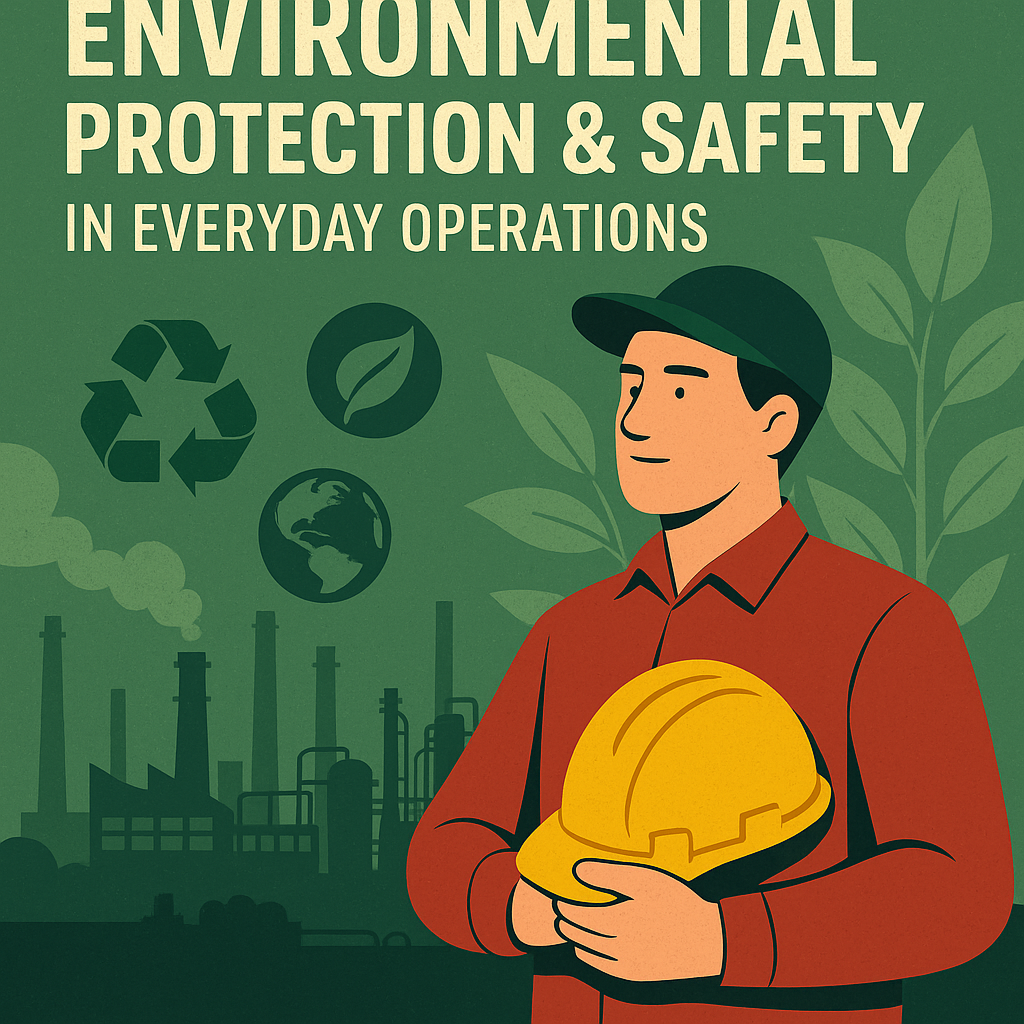Introduction to Environmental Protection and Safety
Environmental protection and safety in everyday operations are no longer optional—they’re essential. Whether in manufacturing, logistics, retail, or office-based environments, safeguarding both people and the planet must go hand in hand. Companies today are expected not only to comply with regulations but also to lead with purpose. Balancing occupational safety with environmental responsibility promotes not just sustainability—but also operational efficiency and corporate reputation.
The Link Between Safety and Environmental Sustainability
Many organizations treat safety and sustainability as separate silos. But in reality, they are deeply intertwined. For instance, reducing emissions through cleaner equipment enhances air quality for workers. Proper waste management doesn’t just protect the environment—it also prevents workplace hazards. Sustainable practices help reduce fire, chemical, and respiratory risks.
Examples include:
-
Switching to low-VOC paints improves both indoor air quality and environmental impact.
-
Installing LED lighting saves energy and reduces heat, making work areas safer.
Identifying Everyday Operational Hazards
You can’t manage what you don’t know. Identifying risks in your daily operations is the first step toward control. These fall into several categories:
-
Chemical Hazards: Solvents, fuels, industrial cleaners
-
Physical Hazards: Noise, vibration, extreme temperatures
-
Biological Hazards: Molds, bacteria, waste by-products
-
Ergonomic Hazards: Poor workstation setup, repetitive tasks
Each of these can have a dual impact—on employee health and environmental well-being.
Workplace Safety Essentials
A safety-first culture starts with the basics:
-
PPE (Personal Protective Equipment): Gloves, masks, safety glasses
-
Emergency Response Plans: Fire drills, chemical spill procedures
-
First Aid Kits & AEDs: Easily accessible and regularly stocked
Implementing routine safety drills, toolbox talks, and daily checklists can reduce incident rates by up to 60%.
Environmental Risk Management Strategies
A robust environmental safety strategy involves:
-
Conducting Environmental Impact Assessments (EIA)
-
Monitoring Emissions and Pollutants
-
Creating Environmental Incident Logs
-
Setting Reduction Targets for Energy and Waste
Companies can use frameworks like ISO 14001 to manage environmental systems effectively.
Implementing Sustainable Practices
Simple changes can have massive impacts:
| Practice | Benefit |
|---|---|
| LED lighting | Reduces power consumption |
| Water-saving taps | Lowers water waste |
| Electronic documentation | Minimizes paper usage |
| Carpool incentives | Cuts carbon footprint |
Every department—procurement, HR, production—should have sustainability KPIs built into operations.
Essential Products for Environmental Protection
To maintain environmental integrity:
-
Biodegradable Cleaners – Less toxic, safer for all
-
Spill Kits – For oil, chemicals, and hazardous waste
-
Green Seal or EPA Safer Choice Products – Certified safe
-
Recycled Office Supplies – Reduce landfill load
Using low-impact consumables is one of the most affordable ways to go green.
Safety Equipment for Everyday Operations
Keep these in your operational checklist:
-
Fire extinguishers (ABC-rated)
-
Eye wash stations
-
Safety showers
-
Exhaust ventilation systems
-
Emergency signage
Make sure equipment is inspected monthly and fully functional.
Role of Safety Signage and Labeling
Clear labeling and signs save lives.
-
GHS-compliant hazard symbols
-
Color-coded waste bins
-
Exit route diagrams
-
Warning and caution signage for machinery
Effective visual communication reduces errors and improves regulatory compliance.
Waste Management Best Practices
Responsible waste handling involves:
-
Source Segregation
-
Proper Labeling
-
Hazardous Waste Disposal Contracts
-
Employee Waste Handling Training
Digitized waste tracking also helps with environmental audits.
Air and Water Quality Control Solutions
Invest in:
-
HEPA filtration systems
-
Dust and fume extractors
-
Stormwater filtration units
-
Grease trap maintenance
Clean air and water benefit both employees and surrounding communities.
Regulatory Compliance and Standards
Keep up with:
-
OSHA for workplace safety
-
EPA for environmental regulation
-
ISO 14001 for environmental systems
-
ISO 45001 for occupational health & safety
Non-compliance can lead to heavy fines and reputation damage.
Staff Training and Engagement Programs
Ongoing education = continuous improvement.
-
New hire orientation
-
Quarterly environmental workshops
-
Gamified safety challenges
-
Employee feedback systems
Involving employees fosters ownership and innovation.
Technology for Environmental Safety Monitoring
Smart solutions include:
-
IoT sensors for leak detection
-
AI-based safety analytics
-
Carbon tracking dashboards
-
Compliance management software
These tools automate risk detection and help with real-time reporting.
Case Studies of Companies Doing it Right
-
Patagonia: Combines product sustainability with ethical labor practices
-
Toyota: Zero-landfill factories and safety-first production
-
Unilever: Integrated safety and environmental standards across global ops
They show it’s not only possible—it’s profitable.
Challenges in Environmental and Operational Safety
Expect hurdles such as:
-
Budget limitations
-
Lack of awareness
-
Resistance to change
-
Data management overload
Tackle these with leadership buy-in and phased implementation.
Future Trends in Environmental Protection & Safety
Keep an eye on:
-
Smart PPE that monitors fatigue
-
AI-based compliance alerts
-
Blockchain for waste traceability
-
Circular economy models in operations
The future blends innovation, safety, and sustainability seamlessly.
FAQs on Environmental Protection & Safety in Everyday Operations
Q1: Why is environmental protection important in everyday business?
A: It reduces ecological harm, improves safety, boosts brand reputation, and ensures legal compliance.
Q2: What are examples of sustainable safety equipment?
A: Solar-powered emergency lighting, biodegradable spill kits, and energy-efficient HVAC systems.
Q3: How can small businesses implement environmental safety affordably?
A: Start with LED lights, recycling bins, and basic staff training. These have low cost but high impact.
Q4: Which industries need the most environmental safety measures?
A: Manufacturing, construction, healthcare, and logistics.
Q5: What certifications help businesses prove their environmental efforts?
A: ISO 14001, LEED Certification, and EPA Safer Choice.
Q6: How often should risk assessments be done?
A: At least annually—or when new operations, products, or risks are introduced.
Conclusion: A Safer, Greener Way Forward
Integrating environmental protection & safety in everyday operations isn’t a checkbox—it’s a continuous journey. With the right mix of tools, training, and technology, businesses can create safer workplaces and a healthier planet. Start small, stay consistent, and evolve constantly.
Explore More:

